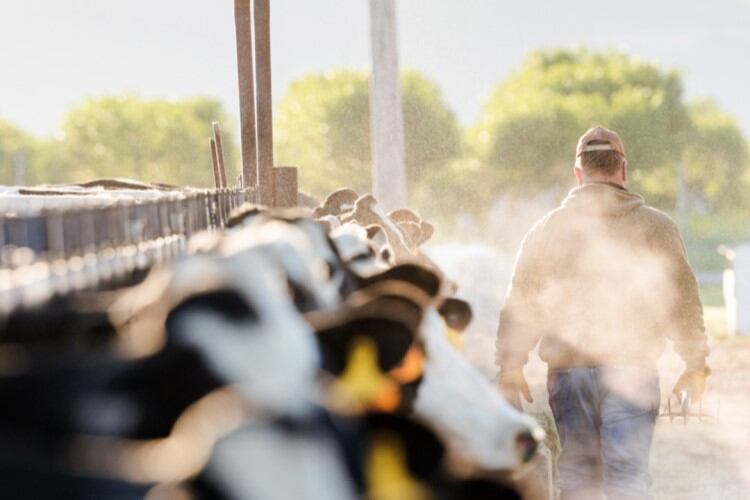The USDA’s Economic Research Service (ERS) has forecasted a 20% average year-on-year (YoY) decline in farm-level net cash farm income – the most significant YoY decline since reporting began in 2010. The steepest decline of 38% is projected in the Northern Crescent, one of the country’s largest dairy-producing areas.
Net farm income, a broad measure of farm profitability, is expected to decline by $42bn in 2023 resulting in a 23% income drop compared to 2022 – the largest farm economy contraction in nominal terms and the third largest when adjusted for inflation.
Overall, dairy farm-level income is projected to drop 81% or $12bn YoY, almost twice as much as the second and third worst-hit sectors, poultry (-43%) and hogs (-39%).
While unsurprising due to elevated production expenses and weakening commodity prices, the drop in farm income points towards a ‘concerning’ outlook according to the US Senate Committee on Agriculture, Nutrition & Forestry as there’s little indication that pricing pressures would abate next year. According to ERS data, cash receipts from sales of crops and livestock products are projected to fall by a combined $23bn this year – of which $20bn is down to price-related declines and less than $4bn – to declines in production. The Committee notes that when federal support is factored in, the projected decline is $12bn, or 2% down from 2022. However, farmers could benefit from additional financial assistance this year through one-off programs, such as the Organic Dairy Marketing Assistance Program (ODMAP) that provided $104m to organic dairies affected by market volatility.
Things looked brighter a year ago. In September 2022, dairy farm businesses were forecast to see an average net cash farm income increase of 64% - the largest increase in the livestock segment. Back then, the forecast increase in milk receipts was expected to offset the higher expenses and lower government payments, on average. Farm businesses in the Northern Crescent were projected to see the largest increase in average net cash farm income at 12%. Carrie Litkowski, a senior economist and Farm Income team leader at the USDA ERS, explained the high net cash receipts for dairy farms with the fact that a lower share of their production expenses came from fuel and interest in 2022, whilst at the same time enjoying larger profit margins compared to other producers, such as poultry.
But with bearish commodity prices and uncertainty in demand, production expenses have remained elevated this year, squeezing farm incomes. According to the latest ERS data, total farm production expenses are projected to increase $29bn YoY to around $460bn; to put this into perspective, since 2020, farm production expenses had gone up by more than $100bn. This trend is unlikely to change significantly into the next growing season, with only marginal input price declines on the cards.
The lower commodity prices have also put pressure on agricultural exports, which are slowing and a record-breaking trade deficit is expected in 2023. Meanwhile, ending inventories of major grains, oilseeds, poultry, and dairy products are projected to increase into 2024. The Committee stated that all this considered, it was ‘reasonable’ to expect that farm incomes could be pressured even lower in 2024. “This is concerning in the face of record-high farm debt, higher borrowing costs, higher break-even levels, and likely downward pressure on farmland asset values due to higher interest rates,” the Committee said in a statement.
The negative farm income outlook could put pressure on lawmakers with regards to the 2023 Farm Bill, which would cut agricultural support by 30% ($8.3bn) for the 2024 fiscal year budget. Congress is expected to put forward a first draft of the new farm bill this month.
Meanwhile, the Federal Milk Marketing Order (FMMO) system is set to undergo its most comprehensive revision since 2000. The USDA is currently holding a public hearing, expected to last into mid-October, to review all proposals. The Department most recently considered the National Milk Producers’ Federation (NMPF) proposal to eliminate barrel cheese from the FMMO protein pricing formula and update milk composition factors. The proposal received ‘strong support’ from NMPF’s member co-op witnesses and was endorsed by the American Farm Bureau. The hearing continues.
Dairy producers have also been putting pressure on the Food and Drug Administration to consider banning manufacturers of dairy alternatives, such as plant-based or cultivated milks, from using dairy descriptors on-pack. Most recently, senators Tammy Baldwin and James E. Risch alongside other signatories wrote to FDA commissioner Robert M. Califf to urge him to "voice our strong concerns over the Food and Drug Administration’s lack of enforcement of dairy standards of identity and bring to your attention the emergence of cell-based imitation products to market".
The senators argued that 'for decades' the federal agency had allowed non-dairy products to use dairy terms to label 'imitation products' and urged the regulator to prevent cell-based dairy product manufacturers from using dairy terminology.



